CHEMICAL MAKE UP of the SKIN, HAIR & NAILS
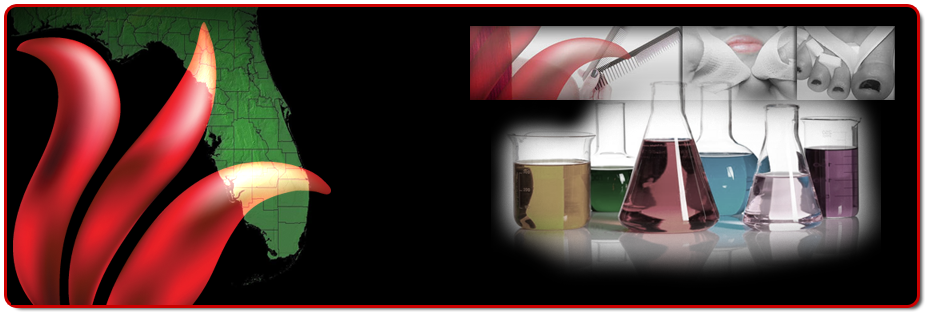
QUICK SCROLL MENU>
I - INTEGUMENTARY SYSTEM
II - (PH SCALE) POTENTIAL HYDROGEN
III - ANATOMY OF THE SKIN
IV - ANATOMY OF THE HAIR
V - ANATOMY OF THE NAIL
I - INTEGUMENT means a covering:
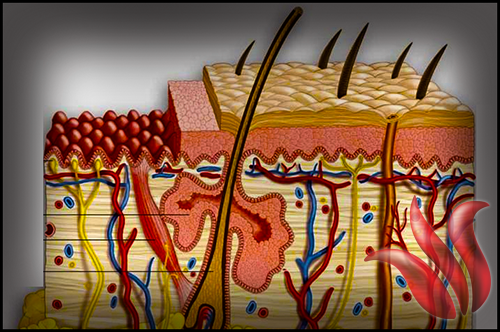
The Integumentary System
Integument means a covering. Our skin is the covering of the body hence the Integumentary System. The integumentary system includes skin, its appendages which are: hair, nails, sebaceous, ceruminous and sweat glands. The skin provides the following functions:
Remember the Acronym: PASSER * Important to Remember
P- Protection as unbroken skin is the body’s first line of defense against infection and offers cushion to the internal organs.
A - Absorption of beneficial substances and reduces the absorption of harmful substances.
S - Secretion - The skin’s sebaceous glands secrete sebum, a complex mixture of fatty acids. Secretions of the skin, hair and nails make up the acid mantle. The acid mantle is the protective coating that shields our delicate tissues from environmental toxins, such as bacteria, viruses and harsh UV rays, which over time cause the greatest environmental damage to the human body
S - Sensation of touch, pressure, pain, heat, cold and textures.
E - Excretion or the elimination of waste through the skins sudoriferous glands.
R - Regulates the body's internal temperature so that the organs can function properly.
II - POTENTIAL HYDROGEN (PH)
Though our goal as cosmetologist, estheticians and nail specialists is to provide results oriented services, we must respect the complex function of the acid mantle in order to healthfully enhance the overall beauty of our clients. The salon professional must have a working knowledge of the anatomy of the skin, hair and nails as well as a solid understanding of the proper methods of manipulation to the acid mantle in order to obtain and provide complete optimal salon treatments.
In addition to the anatomy of the skin, hair, and nails, this block of instruction will concentrate of the use of specific pH on the skin, hair and nails in order to change and optimize physical characteristics. Before we began to delve into each area of the amazing network of the Integumentary system, let’s take a look at the pH scale and how, as a professional you can utilize it in order to get results!
Definition : Potential Hydrogen is the unit of measurement that indicates whether a substance is acidic, neutral or alkaline. Only matter that contains and/or dissolves water can possess an acidic or alkaline nature, water being neutal (7). Just as degrees measure temperature and inches measure distance, PH measures the amount of acidity or alkalinity of something. What determines the acid or alkaline value of something? PH is determined by the number of positive hydrogen ions or conversely, the number of negative hydroxide ions it contains. Specifically, if a solution has more positive hydrogen ions it is acidic. If a solution has more negatively charged hydroxide ions, it is alkaline.
PH SCALE : As a ruler measures inches and centimeters, the PH scale measures potential hydrogen. The PH scale ranges from 0 to 14. The number 7 is the mid point; the point of neutrality. Everything with a value between 0 and 7 is considered to be acidic. The skin, hair and nails are all slightly acidic with a shared PH of approximately 5.5. In contrast, everything with a PH value of more than 7 to 14 is considered alkaline. Note, each number on the PH scale denotes a difference of 10. For example a PH of 6 is 10 times more acidic than neutral 7. Conversely, 6 is 10 times LESS acidic than 5.
What does PH mean to the Beauty Professional?
Think of the PH measurement as a number which denotes the comfort level of the skin, hair and nails. The skin, hair and nails all employ the protective function of the acid mantle. It is the acid mantle which makes it possible to determine the PH of the skin, hair and nails. As stated before, the skin, hair and nails all share a slightly acidic PH of 5.5. Meaning, each exist in a state of homeostasis with a PH value of 5.5. So, for the skin, hair and nails, 5.5 is the magic number for maximum comfort.
It is similar to the commercials for sleep number beds! The wife needs a soft low number in order to get a restful night’s sleep whereas the husband needs a firmer larger number so that he will not awake with aches and pains. The concept is the same for human skin, hair and nails. Products that are “Skin Friendly”, or rather, have PH values which mimic the PH of the skin hair and nails, do not disturb the protective eco system of the acid mantle of the skin hair or nails. Skin friendly products support the daily functioning of the skin, hair and nails. With that in mind, also note that stylist and beauty technicians can manipulate the ph of the skin hair and nails during professional treatments in order to change their physical constitutions, thus creating optimum results!
Manipulating PH in the Treatment Room:
Introducing various PH values to the skin, hair and nails will change the physical makeup of the areas to which the solution is applied.
* Important to Remember
Acidic Solutions
- tightens integumentary tissues, constrict the body’s blood network as well as eliminate water.
Alkaline Solutions
- soften and expand tissues, dilate or open the blood network and breakdown oil and eliminate water..
Cosmetologist, skin care therapist and nail technicians alike all manipulate the PH of the Integumentary System in order to obtain results. Below are a few of the professional services which change PH.
Facial - Desincrustation/ Alkaline wash
These treatments both employ the use of extremely alkaline solutions (PH @12) in order to aggressively breakdown oils (sebum) in the skin. Desincrustation solutions are typically done before extractions because in addition to degreasing the skin, the solution also softens skin tissue relaxing the follicle opening making extractions easier. In addition to a very alkaline PH, alkaline washes contain enzymes which force the skin to slough off; hence they are used at the beginning of professional facial treatments in order to effectively prepare the skin for the skin specific treatment. Alkaline wash allows the treatment solutions to absorb more readily and evenly into deeper layers of the skin. Think of it like the dusting of furniture. You wouldn’t put wood treatment oil on your dining room table before you removed the layers of dust. Another benefit of an alkaline wash is that the wash, over a series of treatments will remove the unwanted hairs on the tip of the nose.
Permanent Waving
Stylist will mold the hair to its desired texture, utilizing huge rollers for straight hair, tiny rollers for curls, and then introduce an alkaline solution to the cortex of the hair which ultimately breaks apart the united keratinized cells. Then the stylist will introduce an extremely acidic solution which will re-establish a connection between the cells of the newly textured hair. Because the process of chemical waving does not affect the root of the hair, this service is deemed temporary as new growth is already programmed with the individual’s natural cortex.
Chemical Texturizing of the Hair
Whether an individual wants straight bone straight hair or she desires a day at the beach soft sexy waves. The hair stylist can customize the texture of the hair to meet her exact needs! This manipulation is called permanent waving. Stylists will mold the hair to its desired texture, utilizing huge rollers for straight hair, tiny rollers for curls, and then introduce an alkaline solution to the cortex of the hair which ultimately breaks apart the united keratinized cells. Then the stylist will introduce an extremely acidic solution which will reestablish a connection between the cells of the newly textured hair. Because the process of chemical waving does not affect the root of the hair, this service is deemed temporary as new growth is already. programmed with the individual’s natural cortex.
PH of Retail Products:
Products that you are retailing to your client for home care use should match that of the skin, hair and nails as closely as possible, (slightly acidic in PH). As professionals, our responsibility is to perform results oriented services. Manipulating the client’s skin, hair and nails is a necessary part of that goal. Client’s main responsibility however, is to protect their skin hair and nails, thus safeguarding their results! You have learned that the skin, hair and nails react differently depending on the PH of a solution. More specifically, PH can literally change the physical makeup of the skin, hair and nails allowing products to penetrate faster and deeper into the skin. PH can change the texture of hair and introduce semi-permanent materials into the fingernails. This manipulation of PH is best left to the professional as negative cosmetic and health effects can be caused from improper application of PH.
FOR EXAMPLE : A client with acne, determined to remove oil, washes frequently with a cleanser which has an alkaline pH. Thus, the cleanser leaves the pores open, removes water and oil from the acid mantle. Her acne worsens.
Why? Human sebum contains strong antibacterial properties. Bacteria that cause acne are only harmful after they have penetrated into the skin. It is within the skin that oil is a growth medium for bacteria. The protective nature of the oils atop our skin should not be stripped away by harsh alkaline cleansers. The removal of the acid mantle is allowing bacteria to penetrate more readily. Also, the body reacts to the dehydration caused by the alkaline cleanser by creating oil underneath the skin. The client needs an antibacterial cleanser in which the pH mimics the client’s skin.
Client is using an alkaline over the counter shampoo and conditioner daily and finds that their hair seems to be frizzy, oily at the root yet, very dry throughout the hair.
Why? The alkaline cleanser is stripping the hair of the shield of the acid mantle of sebum, thus stimulating the sebaceous glands to produce more oil. Hence, the oily scalp yet, the dry frizzy ends. The client needs a shampoo and conditioner with a pH that mimics that of the clients scalp.
III - ANATOMY OF THE SKIN
There are three distinct divisions of the skin: Epidermis, Dermis, and Subcutaneous.
THE DERMAL SYSTEM / THE 3 LAYERS OF THE SKIN
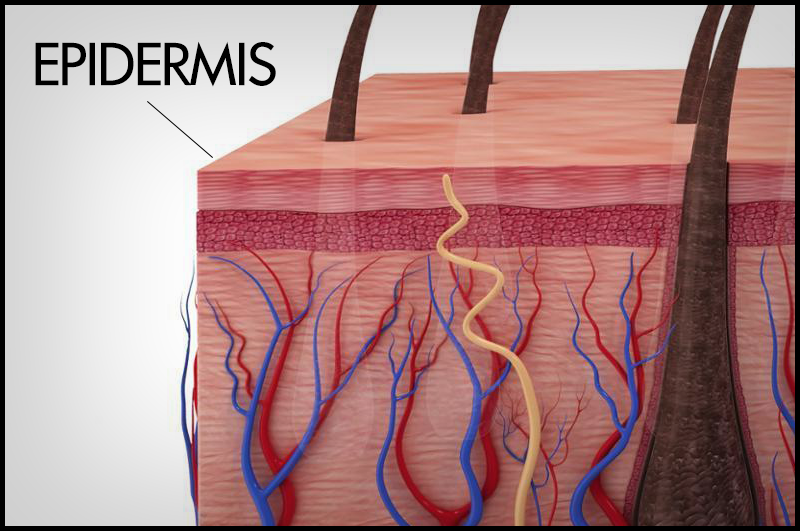
1 - EPIDERMIS
The epidermis is the outermost layer of the skin.
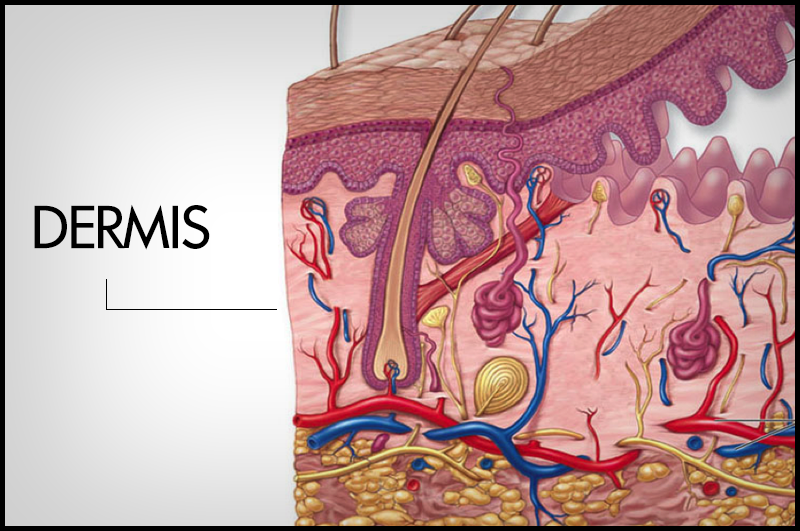
2 - DERMIS
Also referred to as the true skin or the live layer because dense connective tissue, blood vessels, nerves, lymph vessels, smooth muscles, sweat glands, hair follicles and sebaceous glands
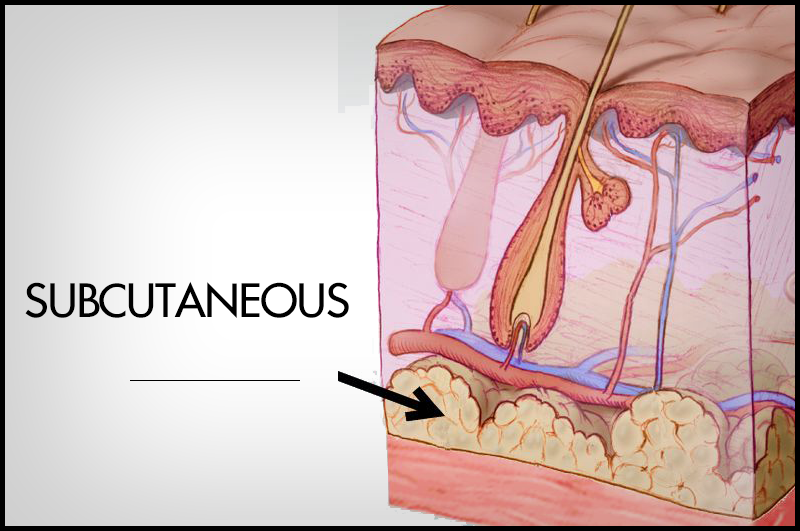
3 - SUBCUTANEOUS
Also referred to as the hypodermis because of its positioning beneath the dermis is made up of adipose or fat cells.
1 - EPIDERMIS
The Epidermis is the outermost division of the skin. It is in the epidermis that keratinization occurs. The process of keratinization begins with mitosis. Mitosis is when skin cells are born by dividing in half. These cells then travel up through the epidermis creating distinctive layers. The distinctive layers the skin cells create are called strata.
As the epithelial cells work their way to the surface of the epidermis, they change shape and chemical composition because they lose most of their water and eventually die. This evolution of the skin cells is what makes each strata distinct.
THE STRATA
Stratum Germinativum
(STRAT-um-jer-mih-NAY-tih-vum)
Gives birth to skin new cells through a process called mitosis, dividing in order to duplicate.
Melanocytes
Produces skin color, irregularly shaped their cell bodies extend and weave between the other epithelial cells of this layer. Melanocytes are activated to produce melanin by exposure to sunlight. Everyone has the same number of melanocytes, but every person has specific genetic information or rather their genes are programmed to produce different amounts of melanin. This is because all humans evolved in Africa. The first humans had to withstand scorching temperatures, 20 degrees higher than the average temperature today as well as long periods of drought. Subsequently the stratum Germinativum is approximately 70% water in this basement layer of the human shield. Overtime, humans migrated away from the equator to regions such as the Baltic states of Norway and Sweden in search of more resources and mild temperatures. This migration caused genetic recombinations which govern the activity of melanocytes. Hence, the many variations of skin color we see today.
Stratum Spinosum
(STRAT-um spy-NOH-sum)
Here the cells are prickly or spiny shaped skin cells. ere cells come to die! The dead cells are converted to protein. Keratinized cells converted
Stratum Granulosum
(STRAT-um-GRAN-you-LHO-sum)
The Stratum Granulosum has grainy like cells and these cells lose their nucleus and become compact and brittle.
Stratum Lucidum
(STRAT-um-LOO-sid-um)
The Stratum Lucidium is a clear layer as the skin cells become transparent and thick.
Stratum Corneum
(STRAT-um-CORN-E-um)
The Stratum Corneum is made of a protein called keratin. It is this layer that prevents absorption of harmful substances and protects us from our environment.
2 - DERMIS
Also referred to as the true skin or the live layer because dense connective tissue, blood vessels, nerves, lymph vessels, smooth muscles, sweat glands, hair follicles and sebaceous glands are all embedded in the dermis. The dermis can be divided into two sub layers; the papillary dermis and the reticular dermis. Papillary portion is the sub layer that houses the blood vessels or capillaries which nourish the overlying epidermis Reticular dermis is the deepest layer of the dermis. Within this layer live fibroblasts. Fibroblasts are specialized cells whose main function is to make collagen and elastin; thick fibrous proteins which give the skin its strength and turgor.
3 - SUBCUTANEOUS
The subcutis, also referred to as the hypodermis because of its positioning beneath the dermis is made up of adipose or fat cells. This layers main job is to act as a cushion in that it protects our internal organ systems from trauma.
IV - Anatomy of the Hair
Hair is a main characteristic of all mammals. In some parts of the body, hair is so small it seems invisible yet, in other places it is very obvious as on the head, armpits and around the genitalia. The amount of hair a person develops is related to complex genetic factors.
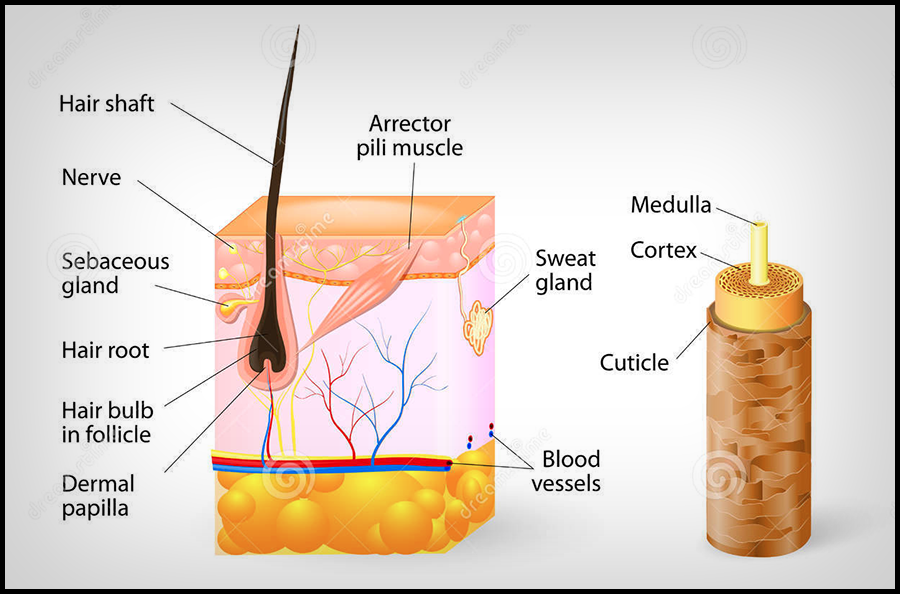
Hair is a main characteristic of all mammals. In some parts of the body hair is so small it seems invisible, yet in other places it is very obvious as on the head, armpits and around the genitalia. The amount of hair a person develops is related to complex genetic factors.
1. Shaft
Outermost, visible portion of the hair. The shaft of the hair is coated with sebum. This sebum makes up the acid mantle of the hair.
2. Cuticle
Outermost portion which consist of several layers of overlapping scale like cells.
3. Cortex
Principle portion of the hair. It is the cortex of the hair that contains pigment and thus is responsible for the different shades of hair color. It is also in the cortex where kerinatization is most active. It is this process which actually determines the texture of an individual’s hair. The keratinized cells which makeup the cortex are united, elastic, dense and fibrous. These cells are also elongated. The degree of this individualized lengthening of the cortex cells is what gives hair its different textured appearance. For example, curly hair’s keratinized cells are less elongated than the cells of straight hair.
4. Medulla
The central or middle part of the hair is the medulla. The cells that make up the medulla have many sides. Furthermore within these cells are many pockets of air.
5. Hair Follicle
Within the hair follicle, the actual root or bulb of the hair is connected to blood vessels which nourish the growth of the hair. The epidermal cradle continuous with the stratum germanitivum is where the hair rests. Because the hair follicle is an involution of the epidermis, the growth of the hair is very similar to that of the skin. Mitosis, the division of cells starts in the root of the hair. As a result of the skin cells in the stratum gernamitivum pushng upwards, hair cells are pushed outwards toward the hair shaft. During this journey the hair cells keratinize and eventually will make up the hair shaft. Hair growth cycles vary from person to person. Generally, scalp hair grows for three years and rest for 1 to 2 years.
V. ANATOMY OF THE NAIL
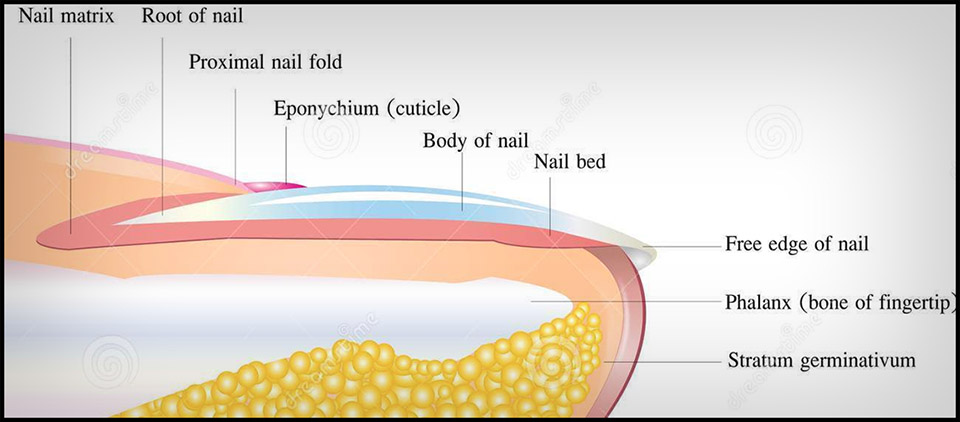
While our furry mammal friends such as birds, cats, dogs have claws, humanoids have finger and toe nails. The nail, technically referred to as onyx (AHN-iks) is actually leathery epidermal skin cells which modify our outermost layer of skin at the hands and feet. Their function is to create traction and grip for us as well as provide protection from predators. A healthy nail is whitish and somewhat translucent, with a pinkish hue apparent. Nails are porous, allowing water to pass. The water content of the nail actually depends on the environment. It is the water content of a nail thiat gives the nails their flexability.
1. Nail bed
Is the bed of living skin where the nail plate, or hardened keratin sits. The nail bed is supplied with many nerves and is enriched with many blood vessels.
2. Matrix
The actual root of the nail. The matrix is composed of nerves, lymph, and blood vessels which provide the nourishment for the nail to form. The visible portion of the matrix is the lunula. The lunula extends from underneath living skin, out and underneath the nail palate. The lunula is the white half moon shaped area at the bottom of the nail.
3. Nail Plate
Most visible portion of the nail. The nail plate is composed of 100s of layers of nail cells whose primary function is to manufacture the hard keratinized nail plate.
4. Cuticle
Dead, sticky tissue attached to the nail plate. The cuticles job is seal the space between the nail plate and the living skin of the finger above the nail plate. The seal that the cuticle created protects the matrix from microorganisms, thus preventing infection and disease.
5. Eponychium
(ep-oh-NIK-eeum)
Living skin at base of the nail plate. Cuticle tissue is attached to the underside of the eponychium and the top of the nail plate. As the nail plate slides along the nail bed, growing out, the cuticle breaks away from the eponychium and eventually serves as a protective seal between the nail plate and the eponychium.
6. Hyponychium
(hy-poh-NIK-eeum)
Slightly thickened skin underneath the free edge of the nail plate (portion of nail that extends over the tip of the finger). This tissue protects the underside of the nail plate from infection.
SUMMARY
Our integumentary system along with its appendages offers the human body important protection and functions. To ensure that protection is optimal we must take measures to maintain a healthy pH balance. This must be achieved even when performing various services that require a disruption of natural pH for desired results. Armed with a solid knowledge of the structures and physiology of the skin, hair and nails makes obtaining those results easier and more attainable.
WORKS CITED:
Milady Standard Cosmetology. Clifton Park: Cengage Learning, 2016
Rizzo, Donald C., Fundamentals of Anatomy and Physiology. Clifton Park: Cengage Learning, 2015
